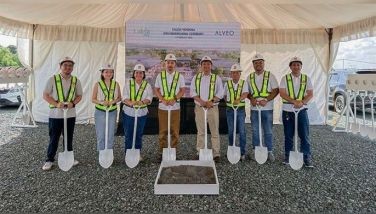Economy jumps 6.4% on strong industries, services
MANILA, Philippines - The country’s economy grew by 6.4 percent in the second quarter, driven by a strong industry and services sector as well as robust remittances.
The April to June gross domestic product (GDP) growth was faster than the 5.6 percent posted in the first three months of this year, but slower than the 7.9 percent in the second quarter of 2013.
Socioeconomic Planning Secretary Arsenio Balisacan said the country’s second quarter performance was similar to Malaysia’s, but inferior to China’s growth rate of 7.5 percent.
In the first quarter this year, Malaysia was second to China in terms of growth.
Balisacan, director-general of the National Economic and Development Authority (NEDA), said there is a “strong likelihood” that the 6.5 to 7.5 percent growth target for the year would be achieved.
“But to achieve our full-year target, the economy must grow by an average 6.9 percent in the second half,” he said. “The public sector will be the main driver of growth in the second semester.”
Private construction increased by 12.7 percent during the second quarter compared to last year, while public construction lost steam.
On the supply side, most sectors demonstrated strong growth, again except for the construction sector.
Agriculture grew by 3.6 percent, a rebound from 0.2 percent contraction in the second quarter last year. This was due to the big turnaround in major crop harvests.
Industry grew by 7.8 percent, partly moderated by the weak performance of the construction industry.
The services sector expanded by six percent as increased activities were reported in trade, real estate, transport, storage and communications, among others.
“This was in response to the increased demand for business process management and the expansion of economic activities,” the NEDA chief added.
Balisacan explained that the decline in public construction was the result of lower spending in infrastructure and other capital outlays, particularly in the months of April and May as major government agencies posted lower-than-programmed disbursements.
“We have already identified the reasons for this under-performance. Examples are the delayed submission of new requirements indicated in the General Appropriations Act (GAA), ongoing validation of proposed programs under the Grassroots Participatory Budgeting, and the revision of work programs to respond to the reconstruction needs in the Yolanda-affected areas,” he said at press briefing yesterday.
Nevertheless, an expectations survey shows that businesses are maintaining their positive outlook on the economy.
“We are aware that market players are still looking for more positive signals, in particular the public sector’s key role in infrastructure spending and consumption of non-durables,” Balisacan said.
Finance Secretary Cesar Purisima said the second quarter growth rate “demonstrates the increasing resiliency and diversity of the Philippine economy with varied sectors of the economy leading our growth.”
“This is positive news for our country, as the second quarter figure shows the potential of the Philippines to sustain inclusive economic development as new sectors of the economy begin to pick up speed. But we can do better,” he said.
Purisima said increased public spending would translate to much higher economic growth.
“We are confident the fundamentals of rapid growth are in place and some adjustments in government disbursements will bring growth to a higher path,” he said.
“To realize our potential to grow even faster, President Aquino’s administration will continue to focus efforts on institutionalizing good governance reforms, including but not limited to Fiscal Incentives Rationalization, Tax Incentives Monitoring and Transparency Act, shortening the Foreign Investments Negative List, and the Amendments to the Build Operate Transfer Law that will support our already successful public-private partnership program,” Purisima pointed out.
He cited the recent passage of a bill liberalizing the Philippine banking industry as part of the government’s commitment to realize full potential. The measure allows foreigners to own 100 percent of a local bank.
Concerns remain
Business groups, meanwhile, expect the country to post strong economic growth for the rest of the year but concerns remain over port congestion as well as unstable energy supply.
“The economy appears to be on the steady upswing going into the second half of the year. However, we also maintain that there remains space for improvement,” Makati Business Club (MBC) executive director Peter Perfecto said in a text message yesterday.
“Agricultural development, addressing port congestion, ensuring energy supply, accelerating infrastructure construction are areas wherein MBC is currently working with the other business groups to find a solution. We will continue to engage the relevant parties and hope that there will be positive effects later on in the year,” Perfecto said.
Management Association of the Philippines president Gregorio Navarro said that while the second quarter result is positive, the group is concerned that congestion in Manila’s ports would have a severe effect on the GDP.
“Manufacturing may be hurt by the truck ban and port congestion but hopefully other sectors will take up the slack,” he said.
As a result of the truck ban from 5 a.m. to 9 p.m., containers have piled up at the ports. – With Louella Desiderio, Zinnia dela Peña
- Latest
- Trending






























